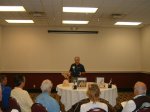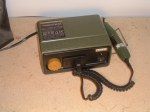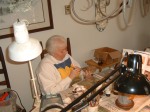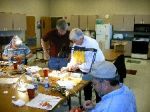 In preparation for an up-coming seminar in Middletown, OH., I stole verbatim from this Blog’s “Glossery” Page, “I” define “Power Carving” as:
In preparation for an up-coming seminar in Middletown, OH., I stole verbatim from this Blog’s “Glossery” Page, “I” define “Power Carving” as:
4. Power-Carving: Traditional woodcarving utilizes conventional hand tools; i.e: knives, gouges, chisles, rifflers, etc. Contrary to popular impressions, so does “Power-Carving”! However; power-carving utilizes a variety of electrical power tools to do a wide assortment of tasks in the removal, sanding and cutting of wood. Power-Tools arguably, can remove wood faster and can create detail on your carving in a manner that can make the various tasks easier. A “fast” knife” carver can possibly carve faster than a “slow” power carver and vice-versa; that’s not the point. ”
Notes continued: New carvers learn (are taught) their earliest techniques using a particular type of tool(s). With perserverance and practice, they inevitably develop proficiency leading to initial successes using their tools of choice. they recieve recognition from their teachers, family & friends on their very first carvings.
Usually, that very first tool is a knife. In my own case, I was encouraged to buy a second knife having a curved blade for the sole purpose of shaping the underside of a bird’s tail. Ca-Ching! Another $10.00 down the rabbit-hole. Haven’t used it for nearly $20.00 years. Also, later that first year I added a set of Palm Gouges which are still useful from time to time. Also, that first year I taught (at their insistance) my first class to 12 students in a church basement. A “free” class for 10 weeks on a Bluejay. Many of the students had power-tools which I had not yet discovered for myself. I still relied on my knife & gouges exclusively. Of course, I had to teach them how to use their power-tools even though they were totally new to me. I noticed the reluctance of many to discard their knives for the “power”. I still surmise that they feared losing their skill-level by diviating from their “first” tools, their knives. Along with the loss of their “edge” with the knife, they might also lose the compliments that came to them with every new carving. I was too new at carving to have that feeling. what many felt might be a big-step-backwards, I saw as the opposite! On the 10th weel’s session, the class presented me (it was close to Christmas) a gift and card of thanks. The gift was a Foredom Flexible-Shafted Rotary Tool which I still use to this day (20 years nearly).
The story I’ve heard repeated several times at Shows is from older guys & gals, standing at our exhibit table looking at our Class Notices Sign-Up Sheet. They would lament that they indeed, owned a Foredom but it was still “in the box”! Afraid to undertake learning how to use it, it remained in the box and they continued to rely solely on their knives, etc. I would always respond that I teach power-carving”! A few have taken lessons over the years. I’m certain that several Foredoms are still in the box!
I’m a “Power Bird Carver”! That doesn’t mean that I don’t appreciate all of the methods and forms of carving practiced by the masses. I do! However, as “Popeye” said, “I yam what I yam”! Let’s be clear; That doesn’t mean that I care what anyone else choose to carve. Nor, do I look down on anyone’s “Art”. The vast majority of our students over the last two decades, were carving anything BUT birds before setting in our classes. I hope that I’ve not encouraged anyone to leave behind some other type of carving. I’d be fine with it to be the world’s only “Bird-Carver”. Actually, I’m grateful that my heros exist to inspire me. I teach power-bird-carving to anyone who wishes to learn it.
Everything you learn carving genres other than birds will come in handy carving birds. Every “hand-tool” you’ve come to rely on carving OTBs (Other Than Birds) will continue to be your friend. Leave No Tool Behind.
Many think that a Dremmel is a power tool; and so it is. It lacks the power to do the necessary hogging of “much wood” and the hand-piece style & size to do the necessarily intricate detailing on a bird. It’s much like trying to carve the eyelid on a humming-bird using a “flashlight”! Dremmels are welcome in my classes; however, they are usually replaced with a Micro-Motor or even, a Flex-Shafted Foredom. I don’t attempt to teach students to carve with the tools they might bring to class, but the tools they should have.
As you get the hang of a power tool, you gain confidence (just as you did with your knife) and learn more applications of it as you go. “It” will take over!
Beginners!!! Can they start out from scratch carving a bird (an Eagle, maybe?) using “Power-Tools”? The answer is YES! Go figure. More than a few have done it in our classes and to our amazement. “Talent” will out!
Firstly, it’s a huge challenge, frought with more than a few hurtles. So, it’s not for the timid or those lacking the “Passion”. Do you know that “Passion” is nearly equal in importance to “Talent”? It certainly is. First hurtle is to invest in acquiring the necessary equipment (See my page on this Blog: “Tools that I Use”) with which to participate in our class. Yes, I have a “new” carver just completing his very first carving of any kind; a Bald Eagle 2/5S, flying. Obviously, he has passion, talent, tools, and a knowlegible teacher. He hasn’t watched me demo, he hasn’t sat in my class so I can watch him. I have never carved on his bird. He has completed an advanced project just by mutual visits for instruction & critique and, access to our reference library. this is a project that proves many points that we’ve made for years. Figure them out for yourself or, just ask. Moral”Don’t or sell yourself short. If you want to do it, you’ve got to try.
The way you have to learn Power Carving is with the tool in your hand; not here and not now! Hopefully, when you do, you will have a competent teacher in the room and at your elbow. Be safe!
Which Tools? Carving is a lot like Golf! Some golfers trade in their old putters every year or so. Others, learn to putt great (or, I’d settle for “better”) by practicing more and by sticking with their “old” original putter. My Foredom Flex-Shaft and my Foredom Micro Motors are my “originals”!
How to start? Just Comment” below on this page to get the ball rolling. I simply solicit your name and e-mail address, which will be added to my “Noticiations” List. About a month prior to a new class, a letter is e-mailed to you with the details. You may respond, or not. If it’s not really for you, we’ll both figure that out eventually. Thanks for listening.
Happy birding and carving, Bill

 Proxxon Pen Sander w/full sized Adapter #PX38001 from Klingspor’s Woodworking Shop (800-228-0000) I’ve had this tool only a week or so and, I like it! The pad of peelable, stickable sanding-strips that came with the Pen are a-bit too finely gritted for my carving purposes; so, I chose several of the variable-shaped sanding bits and used them as patterns for replacement-strips of my own choosing. Klingspor has been easy to deal with and has been very helpful when asked. I see in their catalog that they offer several different grits for this tool. I have a roll of 240 grit fabric-sanding paper (Swiss Cloth from Klingspor) on which I used a ball-point pen to trace the sanding-bit head. I simply scissored the strips and affixed them to the bits using double-sided shop-tape cut in the same shapes. Bingo! Works fine. I happen to be working on a class project, the Eastern Bluebird-open-winged. Lots of patches on the wing-blank-tabs and on the tail where the Pen Sander worked efficiently and effectively in short-order. I could have used my sanding-stick just fine; however, the Pen made the task quicker & easier. Quicker & Easier are always good . especially when the project (ie: Eagle!)! is large and labor-intensive. Consequently, I believe this tool was a good investment for this bird-carver.
Proxxon Pen Sander w/full sized Adapter #PX38001 from Klingspor’s Woodworking Shop (800-228-0000) I’ve had this tool only a week or so and, I like it! The pad of peelable, stickable sanding-strips that came with the Pen are a-bit too finely gritted for my carving purposes; so, I chose several of the variable-shaped sanding bits and used them as patterns for replacement-strips of my own choosing. Klingspor has been easy to deal with and has been very helpful when asked. I see in their catalog that they offer several different grits for this tool. I have a roll of 240 grit fabric-sanding paper (Swiss Cloth from Klingspor) on which I used a ball-point pen to trace the sanding-bit head. I simply scissored the strips and affixed them to the bits using double-sided shop-tape cut in the same shapes. Bingo! Works fine. I happen to be working on a class project, the Eastern Bluebird-open-winged. Lots of patches on the wing-blank-tabs and on the tail where the Pen Sander worked efficiently and effectively in short-order. I could have used my sanding-stick just fine; however, the Pen made the task quicker & easier. Quicker & Easier are always good . especially when the project (ie: Eagle!)! is large and labor-intensive. Consequently, I believe this tool was a good investment for this bird-carver.









